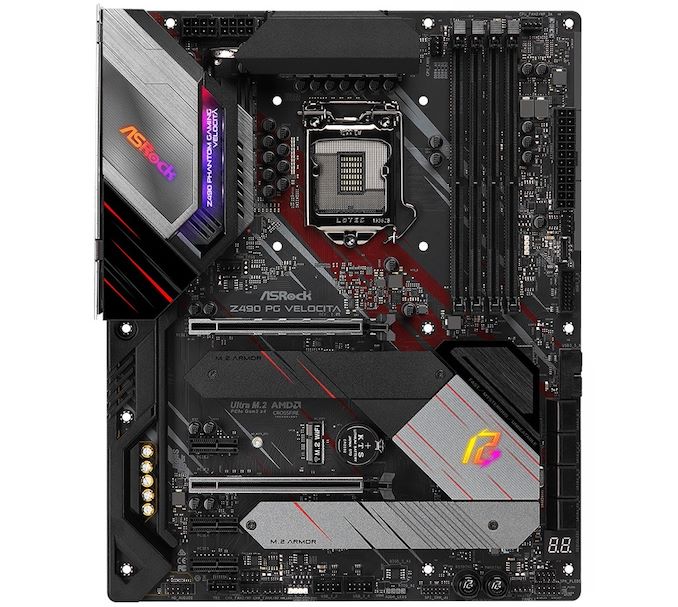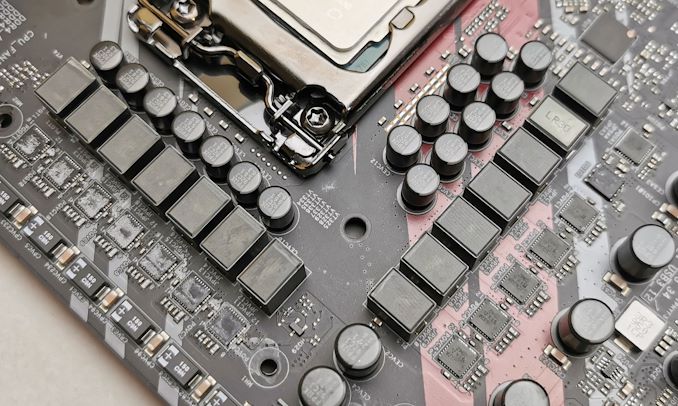The ASRock Z490 PG Velocita Motherboard Review: It Means SPEED
by Gavin Bonshor on September 21, 2020 9:00 AM EST_678x452.jpg)
For the foreseeable future, or at least until Intel's Rocket Lake is likely to be unveiled, Intel's main platform for consumers is currently the Z490 chipset for Comet Lake. The options available for consumers offer a wide variety of models, but perhaps one of the most competitively priced mid-range ones is the ASRock Z490 PG Velocita. Some of the board's main features include dual M.2 slots, eight SATA, 2.5 G Ethernet, and a competitive 13-phase power delivery. This is our review.
Velocitá: High Velocity
One of ASRock's latest model attached to its gaming-focused Phantom Gaming series is the Velocita; an Italian word that translates as speed, but could be interpreted as fast or high-performance. Modeled around the elegance and aerodynamic nature of a fast car with edgy lines, ASRock is no stranger to the 'motherboard as a hypercar' concept. The company used to run a line of 'OC Formula' high-end yellow motherboards with a number of high-end features for overclocking including OLED panels and a waterproof coating.
However ASRock pulled back from those designs, and one could argue the new PG Velocita is just another motherboard with a slightly different aesthetic to a regular Phantom Gaming model.
Opting for a dynamic, yet contrasting look, the ASRock Z490 PG Velocita uses a mixture of colors including black, silver, with red and grey accents throughout. This could be construed as a negative, with multiple areas of RGB LEDs that don't allow the faint red lines across the heatsinks and rear panel cover to be changed, which ends up limiting the customizability. Some of the board's primary features include a pair of Ethernet controllers, one premium 2.5 G and one Gigabit, with dual PCIe 3.0 x4 M.2 slots, eight SATA ports, and support for up to 128 GB of DDR4-4666 memory. There's also plenty of PCIe support with two full-length slots operating at x16/+x4, with three PCIe 3.0 x1 slots. On the rear panel, the PG Veloctia makes use of the native USB 3.2 support of Z490 with two ports, a Type-A and Type-C, with four additional USB 3.2 G1 Type-A ports.
In our performance testing, the ASRock Z490 PG Velocita performed strongly in our system tests with quick non-UEFI POST times, the best DPC latency results out of the box from all the Z490 we've tested so far, and good power consumption at full-loud. Our testing in long idle and idle power states showed the Velocita did run a little hungry on the power, but it's not enough to be a concern. In our CPU and gaming tests, the Velocita flew through most of them at great speed.

The ASRock Z490 PG Velocita undergoing thermal VRM testing
The Z490 PG Velocita is using a 10+2+1 power delivery, with a twelve channel Intersil ISL69269 PWM controller and ten Vishay SiC654 50 A power stages for the CPU section. While performing our usual overclock testing, we saw tight VDroop control, with ASRock's firmware automatically applying Level 1 on the load line calibration settings when altering the CPU VCore voltage. The performance was solid and we saw our POV-Ray benchmark results gradual increase as expected, while our power delivery thermal testing also showed the Veloctia to be a strong performer. It is using a pair of aluminum heatsinks which are interconnected via a single heat pipe, with a pair of small cooling fans which makes the boards cooling solution more effective, albeit at the cost of audible fan noise when under full-load.
The ASRock Z490 PG Velocita has an MSRP of $260 which positions it firmly in the mid-range segment of Z490 models, with Newegg and Amazon currently listing the board on sale at $245; this makes it even more competitive. Other similar models in the price range include ASUS's ROG Strix Z490-A Gaming ($250), ROG Strix Z490-F Gaming ($260), the MSI MPG Z490 Gaming Carbon WIFI ($270), and the GIGABYTE Z490 Aorus Ultra ($290). The $250 to $300 price point is very competitive for Z490 models, with most of these opting for 2.5 G Ethernet and Wi-Fi 6, although the lack of Wi-Fi 6 on the PG Velocita could be an oversight on ASRock's part. It makes for an interesting comparison and review.
Read on for our extended analysis and comparison tests.












16 Comments
View All Comments
Chaitanya - Monday, September 21, 2020 - link
Yay, one more example of lazy engineering: slapping multiple tiny fans with proprietary connectors on VRM heatsoak and calling it a day.rahvin - Monday, September 21, 2020 - link
Why would you test non-UEFI boot times? Is anyone still using legacy Bios?JanW1 - Tuesday, September 22, 2020 - link
That title makes me wanna stop reading Anandtech. How stupid is that for a motherboard review !? This wouldn't even be good marketing, it just sounds immature. As others have pointed out, speed is not a main reason for MB buying decisions, design, build quality and reliability is.PeachNCream - Tuesday, September 22, 2020 - link
While I can imagine the quality of tiny fans has improved significantly over the years, I would still not want anything to do with a motherboard festooned with three of them. There are lots and lots of alternatives at all sorts of price points that do not have or require active cooling of any sort.Archer_Legend - Friday, September 25, 2020 - link
There are several mistakes in the article, as you can see on the box it is written velocità not velocita.javedhashmi - Tuesday, October 13, 2020 - link
Driver Booster Pro Crack is a free driver updater program for Windows that can automatically check for outdated drivers for your hardware on a routine basis, and even download and update all the drivers with one click. The Latest Driver Booster PRO still continues to provide consistency and reliability for those who need to identify and update their drivers. Maintaining a straightforward layout and intuitive features, is now adds several little tweaks, which can make a significant difference.https://crackreview.com/driver-booster-pro-crack/